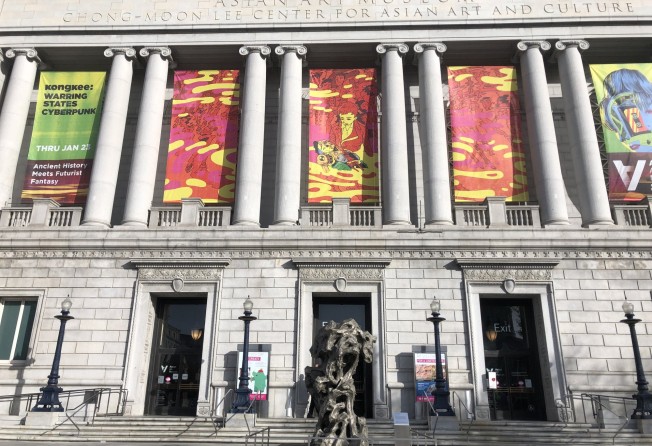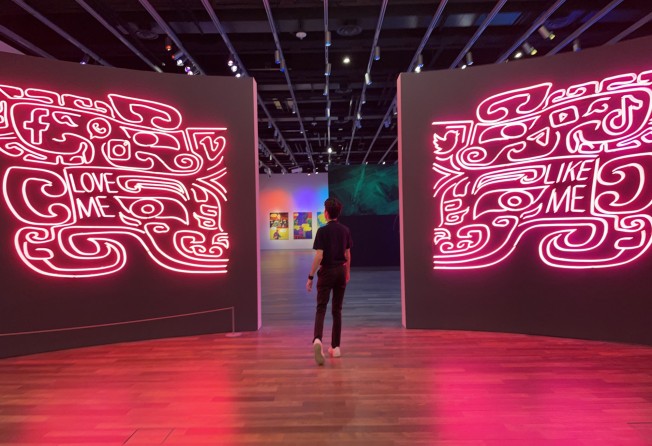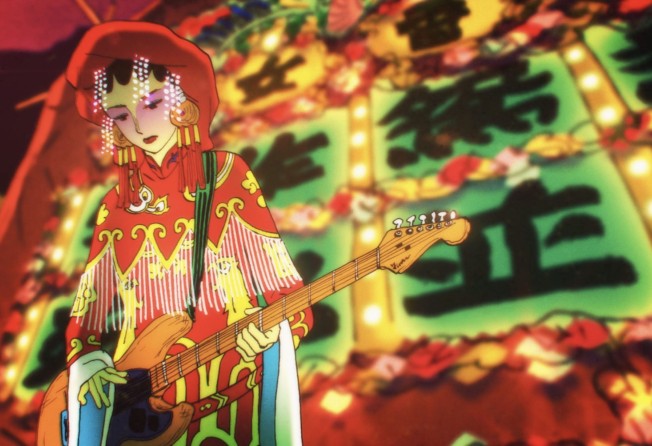
In Hong Kong artist’s cyberpunk dystopia, China’s ‘First Emperor’ rules a future techno-dictatorship. His vision inspires a San Francisco exhibition
- Hong Kong artist known as Kongkee shows a cyberpunk vision of Chinese history in show at San Francisco’s Asian Art Museum, and a twisted view of the future
- Pilots for a film in which Chinese emperor Qin Shihuang finds the elixir of life and rules a futuristic world show alongside video of Hong Kong icons swept away

In September, Kong Hong-chuen (also known as Kongkee) got lucky. Thanks to the sour state of Sino-US relations, the artist was asked by a major San Francisco museum to replace a postponed exhibition from China with his own show based on a Hong Kong-inspired revisionist Chinese history.
That, in itself, is a symbol of Hong Kong’s traditional role as an intermediary between East and West.
“Warring States Cyberpunk”, which took just two months to put together at the Asian Art Museum, is also an advertisement for Hong Kong’s famous efficiency.
Notwithstanding Kong’s adoption of visual clichés such as neon signs, the Star Ferry and tong lau tenement buildings, this impressive show creates the potential for the city to be read as a new kind of cultural symbol – one suited to a sci-fi genre known as Asian futurism which challenges our understanding of technology and progress.
The indefinitely postponed “Lost Kingdoms of Ancient China” would have filled the museum’s new 8,500 sq ft (790 square metre) Akiko Yamazaki and Jerry Yang Pavilion with around 150 bronze age objects from five Chinese museums.
The exhibition was going to be about the phoenix-worshipping Zeng and Chu kingdoms that existed in the messy, war-torn era before Qin Shihuang, ruler of the Qin kingdom, defeated his regional rivals and declared himself the First Emperor in 221 BCE – a period which Kong happens to be fascinated by.

“We were caught in the cross-hair of Sino-US politics and China couldn’t start the shipment. Kongkee was already preparing a side show for ‘Lost Kingdoms’, so I called him up and asked if he could make his show bigger,” says Abby Chen, head of contemporary art at the museum.
Kong, 45, has street cred in Hong Kong as the cartoonist behind the subversive Pandaman series and a one-time collaborator with the British band Blur.
Last year, the city’s M+ museum of visual culture commissioned an interactive video installation from him, called Flower In The Mirror.

Back in his Kowloon Bay studio, Kongkee (in Cantonese, the suffix -kee transforms a surname into a shop brand, like an apostrophe in English) explains that he could meet the tight deadline in San Francisco because he had tonnes of materials for a cyberpunk-inspired, psychedelic animated-film project called “Dragon’s Delusion” that he has been developing since 2013.
In Kong’s dystopian version of Chinese history, which he hopes to turn into a full-length feature one day, the First Emperor’s alchemist Xu Fu finds the elixir of life – and the notoriously brutal ruler is in charge in a future techno-dictatorship where cyborgs and robots co-exist with humans, not buried with the terracotta army as he was in 210 BC.
One of the robots, Joe, has inherited the consciousness and memory of the poet Qu Yuan – a real-life literary legend and a personal hero of Kong who was a court official in the Chu kingdom. His martyrdom by drowning in the Miluo River inspires China’s annual Dragon Boat Festival.

At the entrance to the San Francisco show is a cheeky nod to the exhibition that should have been: a giant pair of pink neon signs in the shape of Taotie, the mythical monster with an insatiable appetite that often adorns bronze age ritual vessels. Kong’s version represents the hunger for data of internet giants and their users’ desire for followers and acknowledgements.
The choice of neon is one of Kong’s many overt signals to Hong Kong culture – an attempt to commandeer exoticised clichés and incorporate them in an imagined future where Asian voices control the narrative. He says the “authentic” Hong Kong is a mishmash of East and West, just as Kong himself is a pastiche of different cultural identities.
His mother, who is Malaysian Chinese, met his father, an illegal immigrant from China, in Hong Kong. She went home to give birth and took baby Kong back to Hong Kong a few months later. He studied fine arts at the Chinese University of Hong Kong while immersed in local pop culture, classic cyberpunk movies and Japanese anime.
This exhibition is sci-fi but it is not about the future. It is about how we feel about today.
Earlier this year he and his wife joined the army of Hong Kong residents who have emigrated to the UK (though he will return often).
His art represents his philosophical approach to upheaval. In the brightly coloured psychedelic space he created in San Francisco are murals, videos and lenticular prints engaged with ideas about perspectives.
These range from images of cyborgs based on previously published trailers and a first chapter of “Dragon’s Delusion” (which was released with crowdfunding via Kickstarter in 2020) to a simple monochrome video called You Can Never Step in the Same River Twice (2022), based on a saying by the Greek philosopher Heraclitus.

A water motif runs through many of the exhibits, which represents the fluidity of identity and the unstoppable force of historic cycles, he says.
River is a video projection in which Hong Kong symbols such as street signs and stone lions resembling the guardian angels of a certain bank get washed away like typhoon debris. While it can be interpreted as a tally of destroyed values, the work can also be interpreted positively as a promise of change.
The screening of three “Dragon’s Delusion” trailers allows Kong to connect his artistic practice with a broader international dialogue about the role of sci-fi in confronting injustice (think Black Panther).

His exhibition, which also contains informative panels on Chinese history and real bronze age artefacts from the museum’s own collection, is an Asian narrative about how we think of the past and our own delusion of progress, he says.
“There is so much hunger for sci-fi developed from people’s own cultural background. This exhibition is sci-fi but it is not about the future. It is about how we feel about today. Technology is the fulfilment of desires, is the elixir of life that the Qin emperor was seeking. But given a second life, would we make the same choices again?”
“Warring States Cyberpunk” is on view at the Asian Art Museum in San Francisco until January 23, 2023.